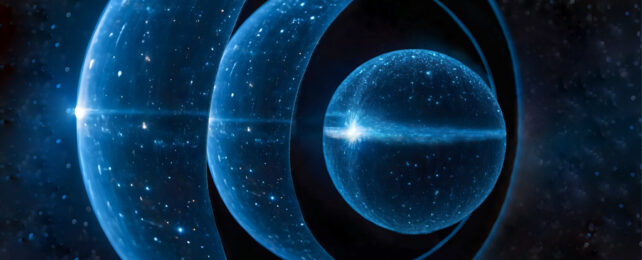Once hypothetical monsters born in a tangled nest of Einstein's general theory of relativity, black holes are now recognized as bona fide celestial objects as real as stars, moons, and galaxies.
But make no mistake. Their engines are still as mysterious as they were when the German theoretical physicist Karl Schwarzschild first played with Einstein's field equations and came to the conclusion that space and time could pucker up into pits of no return.
Goethe University Frankfurt physicists Daniel Jampolski and Luciano Rezzolla have gone back to step one in an attempt to make better sense of the equations that describe black holes and have come away with a solution that's easier to picture, if no less bizarre.
Where more traditional depictions of black holes contain a mess of contradictory physics at their cores, Jampolski and Rezzolla have come up with a unique twist on a gravitationally-confined 'bubble' of material, one that could contain a whole series of bubbles nested within.
"It's great that even 100 years after Schwarzschild presented his first solution to Einstein's field equations from the general theory of relativity, it's still possible to find new solutions," says Rezzolla.
"It's a bit like finding a gold coin along a path that has been explored by many others before."
Black holes hide a dirty secret of physics. Shove enough stuff into a space described by what's known as a Schwarzschild radius, gravity will overcome all other forces and pull that mass into a much, much smaller space. So sayeth the field equations of general relativity.
Yet the equations can't really say what happens at the other end of that big squeeze. As we zoom in on ever smaller distances, quantum physics becomes increasingly important. And with no easy way to bridge the two overarching theories of (nearly) everything, we're left with a big question mark over what happens to matter when gravity squishes it beyond a certain point.
As if that wasn't challenging enough, the very existence of objects that can both send information on a one way-trip into cosmic jail and evaporate in a steady glow of heat known as Hawking radiation presents a physics-breaking paradox, one based on a rule that says information can't simply vanish.
In 2001, quantum physicist Pawel Mazur and astrophysicist Emil Mottola collaborated to make sense of the equations to see if they could avoid these dead ends.
What they came up with was a gravitational condensate star. Snappily referred to as a gravastar, this hypothetical construct describes a film of matter compressed to near impossible thinness, inflated from within by a generous helping of dark energy.
Weird as these stellar party balloons sound, they'd still look like black holes from the outside, while conveniently doing away with the information paradox and avoiding the need for an infinitely dense pinprick of quantum absurdity at their heart.
Jampolski and Rezzolla found it was possible for a gravatar with a slightly thicker membrane to balance a second gravatar within. Similarly, that second nested gravatar could be pregnant with its own exotic shell of highly compressed matter, forming what they call a nestar.
"The nestar is like a matryoshka doll", says Jampolski, who came up with the solution under Rezzolla's supervision.
Inventing cosmic beasts out of the shadows cast by pure theory might sound whimsical, but this is how black holes were identified in the first place. Importantly, finding the limits of what a theory can suggest just might lead to observations that solve the black hole's most vexing conundrums.
"Unfortunately, we still have no idea how such a gravastar could be created," says Rezzolla.
"But even if nestars don't exist, exploring the mathematical properties of these solutions ultimately helps us to better understand black holes".
This research was published in Classical and Quantum Gravity.
